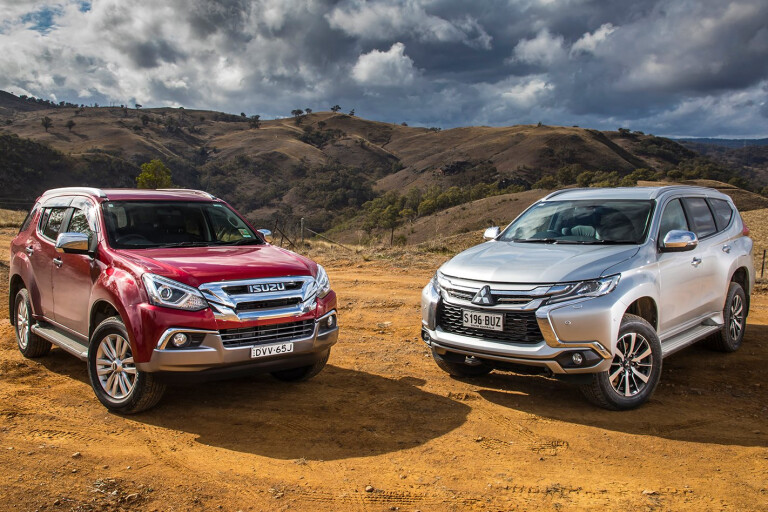
TODAY’S four-wheel drive market is dominated by dual-cab utes, with prospective owners lured by the advertised promise of ultimate versatility.
However, there are still plenty of buyers who shy away from the ‘workhorse’ utes; their harder-riding rear-leaf-spring suspension, rear drum brakes, and lack of third-row seating can be deal-breakers for some. For these buyers, a ute-based 4WD wagon is the better option, with the added benefits of (in most models) an additional row of seating, four-wheel disc brakes, more comfortable coil-spring rear suspension, and a more secure (albeit smaller) cargo space.
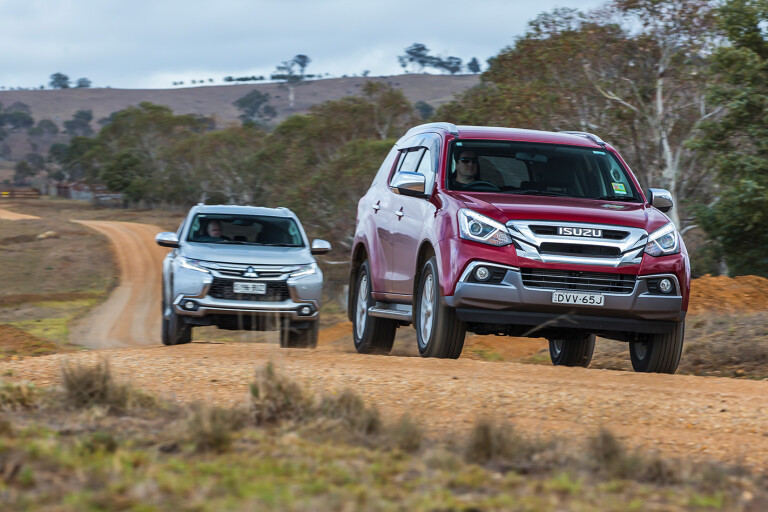
Ford, Holden, Isuzu, Toyota and Mitsubishi all produce mid-size 4WD wagons based off the same platforms as their respective ute models; Ford’s Everest shares the Ranger platform, Toyota’s Fortuner rolls atop a Hilux chassis, Isuzu’s MU-X’s donor is the D-MAX, and Mitsubishi’s Pajero Sport is derived from the popular Triton ute.
These wagons promise plenty: strong, ute-based underpinnings and genuine off-road capability combined with decent on-road manners, all in a relatively compact size compared to large 4WD wagons (think: Toyota Land Cruiser, Land Rover Discovery and Nissan Patrol).
We’ve chosen the two best-selling wagons in this segment – the Isuzu MU-X LS-T and the Mitsubishi Pajero Sport Exceed, both top-tier models – to see if they fulfil the promise of the best of both worlds when it comes to off-road adventure and around-town duty.
PRICE AND EQUIPMENT
OFF the showroom floor the Isuzu MU-X LS-T asks $56,200 from buyers; the Pajero Sport Exceed will set you back $53,650.
The MU-X is powered by Isuzu’s venerable 3.0-litre four-cylinder turbo-diesel engine, backed by a six-speed auto gearbox. The Pajero Sport Exceed runs a 2.4-litre turbo-diesel and offers an extra two cogs via its eight-speed auto.

Both wagons contain myriad safety features including reversing cameras, ABS, EBD (Electronic Brakeforce Distribution), ESC (Electronic Stability Control), EBA (Emergency Brake Assist), Hill Start Assist (HAS), Hill Descent Control (HDC), and each manufacturer’s version of a trailer/tow assist system. Yep, it’s an impressive pile of acronyms.
To these, Pajero Sport adds blind-spot warning, adaptive cruise control, forward collision mitigation and the nifty Multi-Around Monitor – basically a birds-eye-view of the Exceed from above that helps spot obstacles that may be obscured from the driver’s in-cabin viewpoint. It also has one more airbag than the MU-X (seven, opposed to six). Both vehicles are ANCAP five-star rated.
Standard kit for both reflects their top-model specs and includes leather-accented seating for the MU-X (driver’s seat is electric adjust) and the same on Pajero Sport, but with the driver and front passenger’s pews heated as well. Both vehicles have DRLs and keyless entry/start.
Our test MU-X LS-T had factory accessories fitted – tow bar, door scuff plate, slim-line weather shields, rear bumper scuff plate and floor mats – while the Pajero Sport Exceed was as-is, with no additional gear fitted.
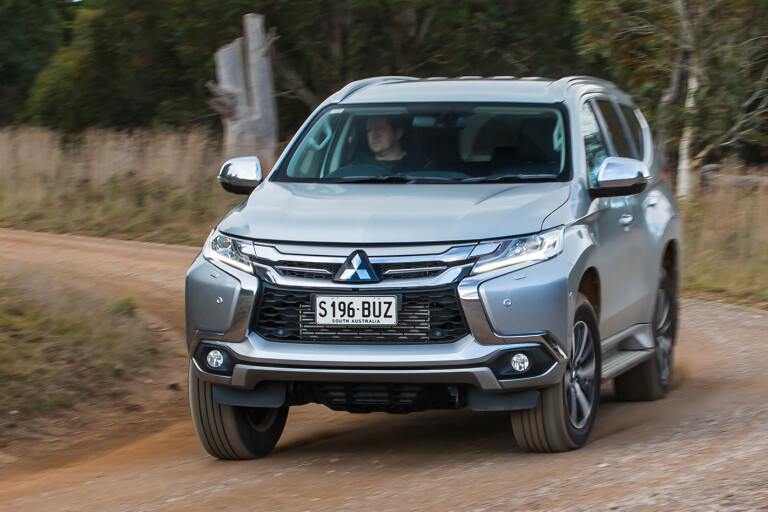
WINNER: Pajero Sport
INTERIOR AND CONNECTIVITY
BOTH interiors are well-featured and comfortable. The MU-X’s leather-accented seats offer a slightly firmer feel and more support, while the Exceed’s full leather jobbies provide adequate support and a more luxurious appearance. The driving position in both affords adequate outward vision, with the MU-X’s larger glass area giving it the slight advantage. The MU-X falls down, though, with a tilt-only steering wheel (the Exceed offers tilt and reach adjustment), necessitating a bit more fiddling around with the seat to get the ideal driving position.
 Conversely, the Exceed’s centre console is overtly wide and noticeably eats into driver legroom. Instrumentation and switchgear on each vehicle is sensibly positioned for easy access; although, both brands could do with making the text/symbols larger (or is it just this reviewer’s ageing eyesight?).
Conversely, the Exceed’s centre console is overtly wide and noticeably eats into driver legroom. Instrumentation and switchgear on each vehicle is sensibly positioned for easy access; although, both brands could do with making the text/symbols larger (or is it just this reviewer’s ageing eyesight?).
The interior styling in the MU-X is more subdued than that of the lairy Pajero Sport, with its overt use of chrome accents throughout the interior (and exterior) somewhat overbearing.
The MU-X feels more generous when it comes to interior space. The second- and third-row seats of the Isuzu offer more space than those in the Pajero Sport; although, slightly surprisingly, it is the Pajero Sport’s second-row seats that feel more comfortable. Even though both third rows are really only for preteens, an adult could bear at least a couple of hours in the third row of the MU-X – there’d be no chance of that in the more cramped Pajero Sport, though.
The MU-X third row is easier to operate when lifting up and packing away, being a simple two-step process (thanks to the seat base being set into the floor) as opposed to the Pajero Sport’s more fussy three-step procedure. Accessing either of these third rows (via the second-row seat being moved forward on both vehicles) is relatively straightforward via a lever on the side of each vehicle’s second row which pushes/folds this row forward, but even with the second row tilted/folded forward there ain’t much squeeze room – only the aforementioned kids or an incredibly flexible contortionist need apply.
With the third-row seats down, the MU-X cargo area offers a decent 878 litres of volume, easily beating the Pajero Sport’s relatively small (for the vehicle’s overall size) 673 litres. For those keen on camping, that extra 200 litres is gold when it comes to stuffing gear inside. Both have numerous nooks for storing phones, books, games, etc.

In terms of in-cabin entertainment, the MU-X seven-inch multi-media touchscreen includes all the usual entertainment options such as DVD, CD, MP3, USB, iPod input and Bluetooth, as well as a rear-mounted DVD player with a 10-inch screen. The Exceed ups the ante with a same-sized touchscreen but one that is inclusive of Apple CarPlay and Android Auto.
WINNER: MU-X
ON-ROAD RIDE AND HANDLING
FOR high-riding 4WD wagons, both vehicles offer decent handling on the bitumen due to firm suspension, reasonably well-controlled bodyroll and respectable – if not lively – performance. Both vehicles run 18-inch alloy wheels: the MU-X runs 18-inch alloys shod with Bridgestone Dueler 255/60R18 H/T tyres; the Pajero Sport uses 18s and the same tyre, but in 265/60R18 format.
The MU-X’s slight disadvantage on-road is its part-time 4WD system that sees it operating in rear-wheel-drive-only on sealed surfaces. The Pajero Sport features Mitsubishi’s excellent Super Select II drive system that offers a constant all-wheel drive mode for optimum traction on bitumen. This isn’t really noticeable in dry conditions, but once the road becomes wet and slippery it offers additional tractive assurance.
The Pajero Sport lives up to its moniker with a more lively on-road driving experience; the steering is more direct and the body and chassis seem more tied-down with less bodyroll, compared to the MU-X.
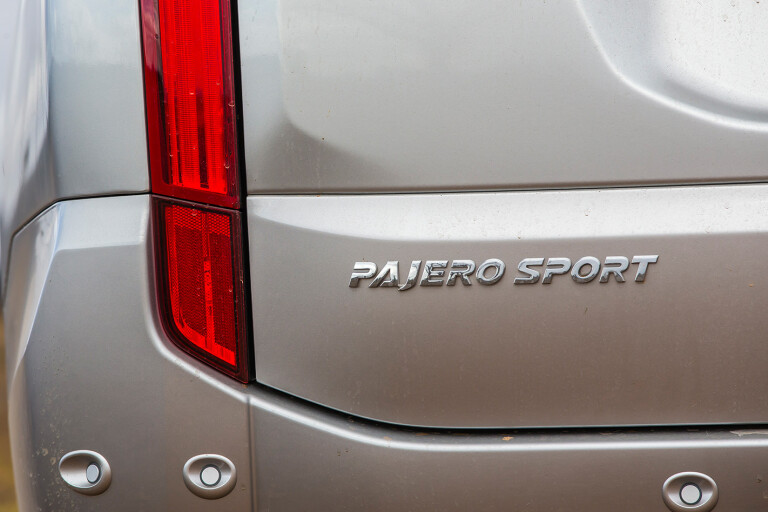
The engines are near-identical in output: the MU-X 3.0-litre produces 130kW and 430Nm; the Pajero Sport’s 2.4-litre offers 133kW and 430Nm. Neither is a powerhouse, but they do generate acceptable performance. The Pajero Sport’s eight-speed auto makes the most of its extra ratios to respond quickly and more smoothly than the MU-X to any sudden throttle application. The MU-X’s under-stressed 3.0-litre still does the job, and it’s only slightly slower once it has kicked down a gear or two.
Claimed combined fuel consumption is 7.9L/100km for the MU-X and a smidge more – 8.0L/100km – for the Pajero Sport.
WINNER: Pajero Sport
OFF-ROAD
THE Pajero Sport Exceed offers a full suite of off-road driving tech: 2WD; 4WD High (4H) for sealed surfaces; 4WD High with the centre diff-lock activated (4HLC) to ensure equal drive is sent to the front and rear axles (only for loose surface roads, i.e., dirt tracks, etc.); and low-range 4WD (4LLC), which also keeps the centre diff locked for optimum traction on rugged tracks and loose surfaces.

Along with its electronic traction control (ETC) system and Hill Descent Control (can be set at speeds ranging from 2km/h to 20km/h), there is a manually-activated rear differential lock (used to ‘lock’ drive equally between the rear wheels) and an Off Road Mode that allows the driver to toggle between Gravel, Mud/Snow, Sand or Rock. This mode alters throttle response, output and braking to suit the particular surface ‘mode’ selected. All of this, combined with ample wheel travel from its solid-beam rear axle, transforms the Pajero Sport Exceed into a capable off-roader in the rougher stuff.
The Isuzu MU-X’s ‘Terrain Command’ system allows the driver to easily select 4WD (High and Low) when on loose surfaces, via its rotary dial. The MU-X has plenty of ground clearance, short front and rear overhangs, and a well-proven tough chassis, which should all point to high off-road capability. It is, however, let down by its reliance on an electronic traction control system that is not as effective as the Pajero Sport’s. There is no option for a rear diff lock with the MU-X, and this, along with slightly less rear wheel travel and that ETC, sees the MU-X scrabbling for traction on ascents the Pajero Sport easily negotiates.
For those who tow a caravan or camper trailer, the Pajero Sport Exceed and Isuzu MU-X LS-T are more than capable, thanks to their trailer-sway control systems and braked towing capacities of 3100kg and 3000kg respectively.
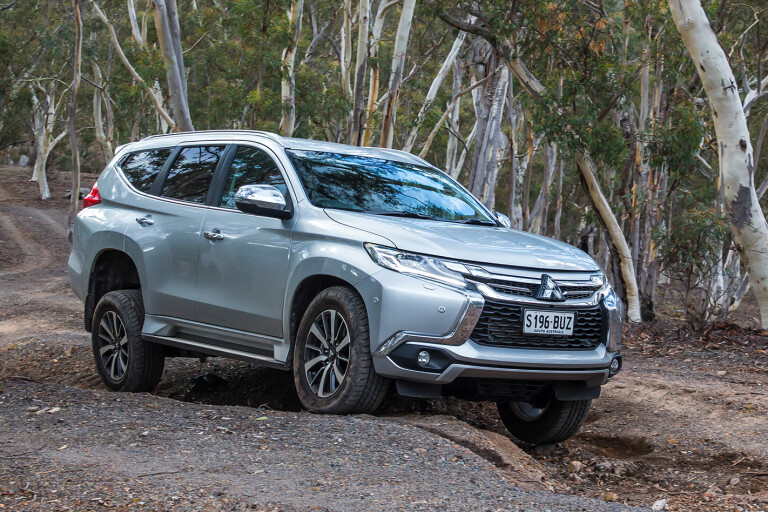
WINNER: Pajero Sport
WARRANTY AND SERVICING
THE MU-X LS-T comes with a five-year/130,000km warranty, plus five years complimentary roadside assistance and capped price servicing for the first five services.
The Pajero Sport has a five year warranty/100,000km warranty but offers only 12 months of free roadside assistance. The Pajero Sport’s capped price service deal is for three years or 45,000km.

WINNER: MU-X
VERDICT
ISUZU UTE has worked hard to push the MU-X in the crowded mid-size 4WD wagon marketplace, and it’s definitely working as the MU-X is the clear segment leader in sales. The sales success is not only through clever promotion at core markets; the MU-X sells well because of Isuzu’s reputation for building no-nonsense, reliable vehicles, with the MU-X’s perceived mechanical ‘simplicity’ viewed as a boon by buyers who travel to remote areas. The MU-X’s other advantage is the proven reliability of its drivetrain, as well as its large interior – especially in the cargo area – where being able to fit a family of four or five, plus all their gear, is a key selling point.
For the more discerning driver or off-road tourer, however, the vehicle’s dynamics let it down on-road and especially off the bitumen, where its Traction Command system – specifically the ETC – isn’t up to the task.

The Pajero Sport Exceed is a more divisive vehicle in terms of styling, with its wedge-shaped silhouette contrasting sharply with the more ‘traditional’ squarish profile of the Isuzu. However, once inside and behind the wheel the Sport Exceed is the more rewarding vehicle in terms of ride and handling, whether it’s on bitumen or tackling a steep, rutted mountain track. The direct steering, smoother eight-speed auto, ability to select constant 4WD on bitumen for optimum traction, and impressive off-road capability, all combine to see the Mitsubishi Pajero Sport Exceed as the more complete overall package and the better offering of these two vehicles.
COMMENTS